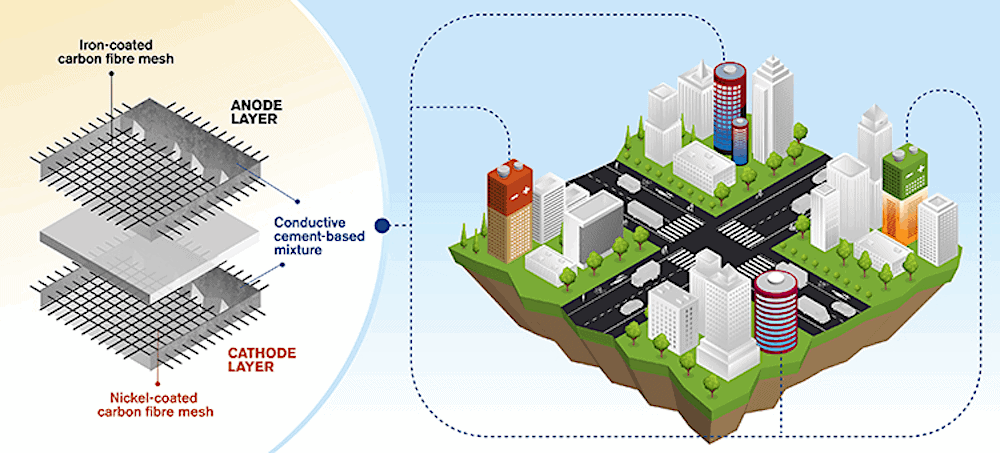
[Image above] Illustration of rechargeable cement-based batteries used as functional concrete. Illustration: Credit: Yen Strandqvist, Chalmers University of Technology
When it comes to renewable energy, one of the biggest obstacles to deploying such technologies on a large scale is developing ways to store all of the generated energy.
Designing batteries with higher energy densities is one approach researchers are exploring to solve this challenge. But some researchers are thinking of something even more radical—instead of improving batteries as we conventionally think of them, they are looking to give buildings the ability to collect, store, and release energy all by themselves.
The idea of turning your house into a battery may sound far-fetched. However, the concept is quite simple when stripped to its foundations—modify common building materials such as bricks and cement to have electrical properties that allow energy collection and storage. Considering the large volume of buildings throughout the world, “the capacity of energy storage can be high, even if the energy per unit volume is not high,” a recent open-access paper explains.
Last August, we highlighted a study by researchers at Washington University in St. Louis on turning bricks into an energy storage device. They coated bricks in PEDOT, a conducting polymer being researched extensively for organic electronics. The process did not affect the mechanical properties of the brick, but the addition of PEDOT meant the bricks could store an electric charge.
Now, two researchers at Chalmers University of Technology in Sweden explored a similar idea with cement. Instead of a conducting polymer, however, they used carbon fibers to imbue the material with energy storage capabilities.
“Results from earlier studies investigating [nonrechargeable] concrete battery technology showed very low performance, so we realized we had to think out of the box, to come up with another way to produce the electrode. This particular idea that we have developed—which is also rechargeable—has never been explored before,” Emma Zhang, formerly of Chalmers and now senior development scientist at Delta of Sweden, says in a Chalmers press release.
In the paper Zhang wrote with professor Luping Tang, they explain how they first mixed small amounts of short carbon fibers into the cement and then embedded a metal-coated carbon fiber mesh. They created and ran electrical performance tests on several meshes containing different metals before deciding to use iron for the anode and nickel for the cathode.

Images of various metal-coated carbon fiber meshes (a–c) and an example of a mesh cast inside the cement-based electrolyte before demolding from the white plastic foam (d). Metals tested include nickel (a), zinc (b), and iron (c). Credit: Zhang and Tang, Buildings (CC BY 4.0)
The final battery had an average energy density of 7 Wh/m2 during six charge/discharge cycles. While this value is low in comparison to commercial batteries, it is potentially ten times better than the performance of previous concrete batteries, according to the press release. In addition, the lower energy density “could be overcome thanks to the huge volume at which the battery could be constructed when used in buildings.”
Zhang says that because concrete infrastructure is usually built to last fifty or even a hundred years, the batteries would need to be refined to last this long or designed for easy replacement when their service life is over.
Though these technical challenges exist, “We are convinced this concept makes for a great contribution to allowing future building materials to have additional functions such as renewable energy sources,” Tang says.
The open-access paper, published in Buildings, is “Rechargeable concrete battery” (DOI: 10.3390/buildings11030103).
Author
Lisa McDonald
CTT Categories
- Construction
- Energy
- Material Innovations
Related Posts
The urban fabric of brick—Part 3: Innovations and the future of design
November 11, 2025
The urban fabric of brick—Part 2: Ancient brick history
October 28, 2025


